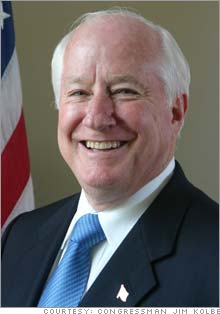|
Kill-the-penny bill introduced Citing spiraling zinc costs, Rep. Jim Kolbe continues his quest to eliminate the 1-cent piece. NEW YORK (CNNMoney.com) -- Representative Jim Kolbe wants to do away with the penny - and for a second time has introduced legislation that would effectively kill it. The Currency Overhaul for an Industrious Nation (COIN) Act would force the rounding off of all cash transactions to the nearest 5 cents, making the penny coin useless for everyday transactions.
The move is in part a reaction to the rising cost of zinc - the penny's main ingredient - which at current prices brings the cost of making the coin to 1.4 cents each. Kolbe introduced similar legislation in 2001 when prices for metals weren't as high. The bill failed to pass or even to make it to a floor vote. Since then, however, zinc costs have nearly doubled. "The penny has been a nuisance for years," said Kolbe (R-Arizona) at a press conference on Tuesday, "but now that the cost of a penny exceeds its value, the landscape of the debate has completely changed." Over half of the U.S. Mint's coin production comes in the form of pennies. At current prices, the Mint would spend some $44 million producing pennies this year, nearly $14 million more than in 2005. As with the 2001 bill, the new one calls for rounding down any cash transaction that ends in in 1,2,6 and 7 cents; totals ending in 3,4,8, or 9 cents would round up. Chuck Todd, editor-in-chief of the political briefing publication, Hotline, thinks it's unlikely Kolbe's bill will have better luck this time. "The only time these coin bills are successful is when you create a collectible," Todd says. The bill does, however, call for various commemorative currencies, including a dollar coin and a $2 bill. A recent Gallup/USA Today also indicates a tough road ahead for the bill. Fifty-five percent of respondents consider the penny useful compared to 43 percent who think it should be eliminated. More telling, 76 percent of respondents said they would pick up a penny if they saw it on the ground. Kolbe's home state of Arizona is the largest copper producing state in the nation. Copper is the main material of the nickel which would benefit by becoming the lowest denomination of currency in circulation. Other elements Kolbe's bill also takes aim at Massachusetts-based Crane Paper, which has been the exclusive supplier of paper to the Bureau of Engraving since 1879. Crane has benefited from legislation requirements that effectively makes it the only possible supplier of the paper. Kolbe's bill would simply require the paper to be "produced entirely within the United States," rather than the current requirements that it be produced domestically by a company 90-percent American owned. Kolbe, as a freetrader, opposes such protectionism. COIN also provides for a study of less costly metals to replace zinc, copper and other materials used in American coins. The bill also calls for organizational changes: Oversight of the U.S. Mint and the Bureau of Engraving and Printing would be transferred from the Department of the Treasury to the Federal Reserve Board. Kolbe's office maintains that since the Federal Reserve is in charge of the dollar, moving the currency under the Federal Reserve would remove a layer of bureaucracy. Others don't see the wisdom in the proposed move. "Sure, you're taking bureaucracy away from the Treasury but you're adding it to the Federal Reserve," said Todd. "Where do you get the efficiency?" --------------------------------- Related: The fight against the penny |
|

